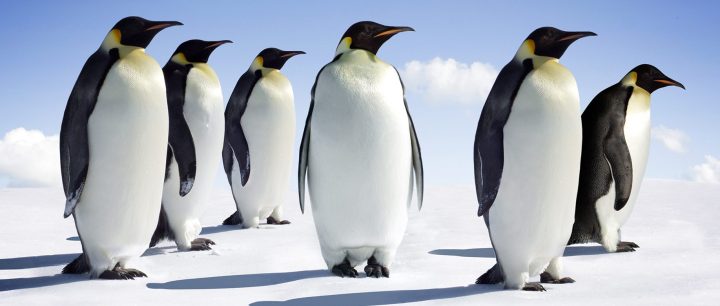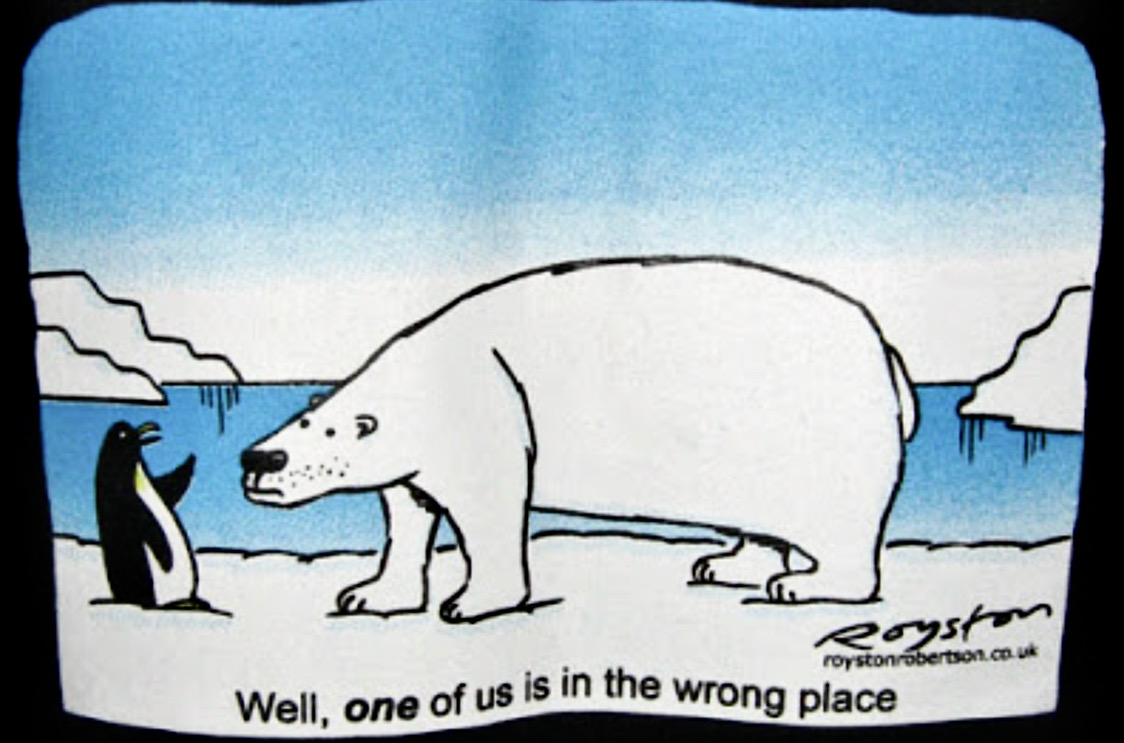GOING AGAINST THE FLOE
Revealed – Why China blocked an Antarctic penguin rescue plan

In documents seen by Daily Maverick, a Chinese delegation at a top Antarctic meeting claimed rising polar bear numbers were among the reasons for stalling a global push to save emperor penguins. But while experts warn the species may go extinct in decades, China has not budged: based on ‘small’ threats – and claims by a controversial Canadian scientist who may have produced no peer-reviewed work on the links between ice loss and polar bears, or even penguins.
What do penguins and polar bears have in common? They are iconic species threatened by warming temperatures in Earth’s icy poles.
Even so, penguins are flightless, aquatic birds that cling to the edges of the icebound Antarctic. Polar bears are not flightless, aquatic birds. They are also not from the South Pole. They are hypercarnivorous apex predators adapted to the extreme opposite end of Planet Earth: the North Pole, and the Arctic Circle that embraces it.
Yet, at an annual Antarctic Treaty meeting in Berlin that ended in a crushing blow for many scientists last week, talks stalled when China refused to support an immediate plan to rescue the world’s largest penguin.
The 1959 treaty devotes Antarctica and its Southern Ocean to peaceful activities such as tourism and science. Signed by more than 50 states, the framework also bans arms, mining and land ownership. And at this year’s meeting, after the warming Antarctic hit record-low sea ice in February, almost all states – including the US, Russia, Ukraine and South Africa – supported a call to conserve the emperor penguin, an outsize polar bird that can reach a height of 1m as an adult.
The annual meeting is considered the gold standard of Antarctic science and diplomacy, but without agreement by all of the treaty’s 29 decision-making states, policy cannot become protection. This year, China’s official delegation blocked the penguin plan that was supported by dozens of states, the Antarctic and Southern Ocean Coalition (Asoc) told Daily Maverick. Asoc was a meeting observer.
Now we can also reveal that China blocked the international penguin plan – led by the UK, and supported by the Scientific Committee on Antarctic Research (Scar), the world’s authority on south polar science – based on claims from penguin and polar bear blogs by a self-confessed “non-specialist”.
In papers tabled at the closed-door treaty meeting, the Chinese delegation proposed the development of a “targeted research and monitoring plan”, but rebuffed special protections.
They also argued that polar bear numbers had been rising and that such claims could be used to inform decisions on emperor penguin management. This, the delegation added, was a “potential” reason for delaying attempts to award the species special protections, a conservation measure aimed at climate resilience, among other factors.

A satirical T-shirt produced for overwintering members of the South African National Antarctic Programme, making fun of common misconceptions that penguins and polar bears share habitats. (Photo: www.roystoncartoons.com)
A global authority on species threat categories, the IUCN’s Red List points out there is “insufficient data” to make absolute claims about polar bear population trends – estimating their “abundance is expensive and difficult because the animals often occur at low densities in remote habitats”. Thus, contradicting China’s claims, it may not be possible to say those numbers are rising. Some of the Arctic predator’s 19 subpopulations may be increasing, some seem stable, some may be falling and nine appear unknown.
However, considering a suite of threats, including shipping lanes, oil and gas drilling, and climate change, the Red List classifies the polar bear as “vulnerable” – meaning the species faces a high risk of extinction. There appear to be about 26,000 individuals left in the wild.
According to the IUCN, the emperor penguin is declining. The Red List classifies it as “near-threatened”. Still, experts hope special protections under the treaty would help uplist the species to “vulnerable”. There appear to be about 260,000 breeding pairs.
But the Chinese delegation suggested the “case of polar bears conservation” was “informed by climate models and the potential similar case of emperor penguins”.
“The truth is that polar bear numbers are the highest they have been in about 60 years as of today,” their paper said. The paper further argued the emperor penguin had also increased in numbers, contending that the international scientific community may have misled the public on both species’ population trends.
That paper appears to offer little data to support its claims, other than blogs by Susan Crockford – a former adjunct professor at a Canadian university who says the climate crisis threatens neither polar bears nor penguins.
Crockford’s blog points out she has an undergraduate degree in zoology. She has also produced multiple documents through the Global Warming Policy Foundation, a UK think-tank whose website claims “climate change policies may be doing more harm than good”.
Citing Crockford’s blog “Polar Bear Science”, the Chinese paper suggests this “could be used as reference materials to facilitate the consideration of Antarctic Special Protected Species issues and particularly the emperor penguin designation”.
‘No peer-reviewed research on sea ice/population dynamics’
In a 2017 study published in the journal BioScience, a group of 14 scientists found Crockford “vigorously criticises, without supporting evidence, the findings of several leading researchers who have studied polar bears in the field for decades”. The study authors include Dr Michael E Mann, an influential climate scientist who in 1999 yielded the clearest evidence yet of human-made warming through his co-authored “hockey stick graph”.
Crockford had, “as of this writing … neither conducted any original research nor published any articles in the peer-reviewed literature on the effects of sea ice on the population dynamics of polar bears”, the BioScience study said.
The former University of Victoria academic did not respond to our requests for immediate comment. But Crockford did subsequently post a blog addressing our concerns, which included queries about her qualifications. We also asked her to address concerns that she had not been published on polar bears and climate change impacts in peer-reviewed journals.
In that post, she criticised “a few scientists” who “have used totally implausible climate models”. The “demise of emperor penguins” was hyped, Crockford wrote.
“I’d suggest that using far-fetched ‘worse-case’ scenario predictions to propose an unlikely but scary-sounding future catastrophe isn’t likely to work any better for emperor penguins than it has done for polar bears, especially when the animals keep thriving,” she wrote.
“Activist conservation specialists studying polar bears and penguins continue to use them to press for special protection status for their beloved species,” she added, writing in a separate post that she was a “professional zoologist with four decades of pertinent experience”.
She had published “many peer-reviewed papers on a variety of topics including Arctic ecology and evolution of Arctic species”, she wrote.
Crockford – who runs a private business on bone identification for a number of species – also wrote she had “a long-standing interest in evolution, including dog domestication”.
“It might be hard to imagine that these interests and skills not only intersect but include polar bears. However, they do. For example, the evolutionary transformation of brown bears to polar bears, and wolves to dogs, involved a similar biological process; bones of brown bears and polar bears, like the bones of wolves and dogs, are similar yet distinctive.”
Publications listed on Crockford’s blog include Fallen Icon: Sir David Attenborough and the Walrus Deception as well as Polar Bear Facts and Myths. Published in “paperback and e-book formats” by Spotted Cow Presentations, the latter says it “explains in simple terms why polar bears are thriving despite the recent loss of Arctic sea ice”.
First few days of the Antarctic Treaty meeting. Interesting papers, a lot of politics (e.g. both Ukraine and Russia are here) and certain countries flexing their political muscle… but overall still an excellent example of international cooperation… pic.twitter.com/At9uYplcI6
— Mike Sparrow (@DrMikeSparrow) May 26, 2022
Exceeding 100,000 Antarctic tourists for the first time
Recently, scientific authorities have sounded alarm bells, warning that time may be running out for the emperor penguin, particularly under climate scenarios caused by burning, among others, fossil fuels – to which China is a major contributor. Without solid sea ice, the emperor penguin cannot complete its breeding cycles and may face extinction within mere decades.
Chinese officials have also repeatedly opposed marine protected areas in the Southern Ocean in recent years. Before the pandemic, said a new report to the treaty meeting by the International Association of Antarctica Tour Operators, “China had seen the greatest increase in travellers to Antarctica”. Sending about 14,000 tourists to the region between 2018 and 2020, the People’s Republic is second only to flows from the US, with about 33,000 for the same period.
The same report predicts a historic moment in Antarctic sightseeing: tourists in the upcoming summer are likely to surpass the 100,000 mark for the first time.
And tourists go where penguins go, Scar’s immediate past president, Steven Chown, previously told us.
But a handful of countries – including China and states advocating penguin conservation – have spent more than a decade dragging their feet to approve the treaty’s only legal agreements aimed at controlling tourism numbers to Antarctica.
Other Chinese papers tabled at the meeting called on treaty states to work harder to protect marine species against vessels, streamline a response to climate change and apply species threats more consistently.
“The known and emerging terrestrial and marine threats affecting emperor penguins are considered relatively small if not negligible, and the considerable uncertainty regarding the threat from climate change and sea ice reduction … is predicted to take place only until after 2050,” they argued, citing a number of world authorities.
Chinese polar authorities did not respond to detailed questions.
‘Vulnerable’ to climate threats
“[The] loss of breeding habitats and the profound transformation of the foraging habitat associated with significant change in and loss of sea ice as part of climate change are primary threats to emperor penguins,” the UK delegation noted in its own tabled paper. The species was “vulnerable to ongoing and projected climate change, thereby warranting protection as an Antarctic specially protected species”.
We had a fantastic opportunity today to share vital #cryosphere science with German Foreign Ministry State Secretary for International Climate Action, Jennifer Morgan @climatemorgan, at the #AntarcticTreaty Consultative Meeting in Berlin pic.twitter.com/JFatugFizb
— International Cryosphere Climate Initiative (@iccinet) May 24, 2022
The paper indicated “the species might best be classified within the IUCN Red List as ‘vulnerable’’’.
South Korean scientists were among those who have expressed alarm, quoting disturbing numbers in their own report.
“The population trend of the species is predicted to be strongly linked to the condition of ice cover around Antarctica,” said the report, also submitted to the meeting. “Under the most optimistic scenario, the global emperor penguin population is projected to decline by more than 50%.”
The IUCN assessment adds: “The future trend is predicted to show an increasingly rapid rate of decline, once changes to the availability of suitable land-fast sea-ice begin to affect breeding success.”
Microplastics in penguin poo
Scientists also detailed microplastics in 20% of examined samples from gentoo penguin faeces, in a paper by the UK and Portugal.
The researchers analysed about 80 samples – “as proof of ingestion” – and found microfibres, fragments and films of “different sizes, colours and polymer compositions”.
Microplastics had recently been found in other penguin species, they said.
Great to see my friend @AlbertLluberas, executive secretary of the Antarctic Treaty Secretariat, at the #Antarctic Treaty Consultative Meeting in Berlin this week. pic.twitter.com/Tcc1Zp3nWC
— Evan Bloom (@EvanTBloom) May 31, 2022
At the end of last week’s meeting, Germany’s foreign ministry pointed out that although the emperor penguin failed to earn universal protections this year, individual states supporting the UK’s efforts would go ahead, and adopt their own legislation to protect some of Antarctica’s most charismatic flightless ambassadors.
“The world’s largest penguin is increasingly at risk, in particular because of global warming. An overwhelming majority of parties held the opinion that there is sufficient scientific evidence for the species to be put under the special protection,” the ministry said. “While a formal decision on special protection status was blocked by one party, most parties indicated that they would nonetheless implement the draft action plan … on a national basis.” DM/OBP




















 Become an Insider
Become an Insider
Having destroyed much of their own environment, the Chinese agenda seems now to be to destroy the rest of the world as well. From increasing the huge tonnage of coal that they already mine to destroying environments in Africa by logging and trading endangered species, there seems no end to their lack of environmental awareness. I almost wish that another pandemic would descend upon them.
The cynic in me thinks that there may be an ulterior motive here. After tiger and now lion bones for fortified wines and amulets, decimation of rhino and pangolin for horn and scales to cure cancer, enhance virility, or just plain vanity. So Emperor Penguins as a further exotic food source? To paraphrase the old hymn, “all things great and beautiful, all creatures great and small…..the Chinese ate them all”. And by the way, the annual Yulin dog meat festival starts soon so tuck in everybody!